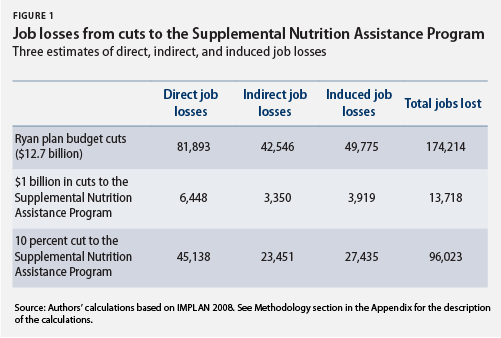Download the full report (pdf)
Download the executive summary (pdf)
Read the report in your web browser (Scribd)
See also: Interactive Map: How SNAP Cuts Affect Your State by Donna Cooper
The importance of the Supplemental Nutrition Assistance Program in combating poverty in our country by alleviating hunger was driven home anew during the Great Recession of 2007–2009 and the subsequent tepid economic recovery. Participation in the program rose during the Great Recession as more families turned to the program to help make ends meet, as breadwinners lost their jobs or found new jobs paying much less, pushing them and their families into poverty. The program is credited with preventing a dramatic increase in hunger and food insecurity in spite of the historically high levels of unemployment and underemployment throughout the Great Recession.
In 2009 the Supplemental Nutrition Assistance Program was responsible for lifting the income of 3.6 million Americans over the poverty line, providing an average of less than $300 in monthly food stamps to families in need. In 2010 this program lifted 3.9 million Americans above poverty, including 1.7 million children, as the Great Recession gave way to an initially very slow economic recovery.
The Supplemental Nutrition Assistance Program continues to help Americans struggling to make ends meet today. This program provided $72 billion worth of benefits to nearly 45 million Americans in fiscal year 2011 ending in October last year. Even though our economy is improving, unemployment and wage stagnation continue to make it difficult for millions of Americans to avoid hunger and food insecurity.
The program also plays an important role in sustaining demand for groceries provided by businesses in communities around the country. Our analysis presented in this paper finds that each $1 billion spent by recipients enables nearly 14,000 Americans to find or keep their jobs. That means approximately 1 million workers were employed last year because of this program.
With long-term unemployment still high, and with overall unemployment expected to drop only slowly for several more years, cutting the Supplemental Nutrition Assistance Program is likely to do significant harm to millions of families and workers. Yet that is exactly what House Republicans proposed to do last year. In the so-called “Ryan budget plan,” named after the principal author of the bill, House Budget Committee Chairman Paul Ryan (R-WI), he proposed a $127 billion cut to the program. A cut of that size would result in the loss of more than 174,000 jobs in the first year. This proposal to cut the program by roughly 18 percent fortunately was not enacted.
It is too soon to know if the FY 2013 House leadership budget proposal, which is due out sometime this month, will propose any cuts to this program. (The FY 2012 budget was largely set by the Budget Control Act of 2011, which prevented a shutdown of the federal government in August of last year.) If cuts are proposed, this study offers policymakers a tool to estimate the employment consequences that will result. We detail our findings in the main pages of this report, but briefly, our study estimates that:
- Each $1 billion reduction in the Supplemental Nutrition Assistance Program eliminates 13,718 jobs.
- A 10 percent reduction in the size of the Supplemental Nutrition Assistance Program would cause more than 96,000 job losses.
- These losses would be particularly strong in food-related industries, which would lose as many as 11,000 jobs under a 10 percent cut to the program.
- Job losses will likely have the greatest impact on younger workers, since they account for a disproportionate share of workers in food-related industries— nearly one-third of grocery employees are under 25, compared to just 14 percent of workers in all industries.

In the pages that follow, we will first detail exactly how the Supplemental Nutrition Assistance Program works, then present the results of our findings.
Jeffrey Thompson is an assistant research professor at the Political Economy Research Institute and Heidi Garrett-Peltier is an assistant research professor at the Political Economy Research Institute.
Download the full report (pdf)
Download the executive summary (pdf)
Read the report in your web browser (Scribd)
See also: